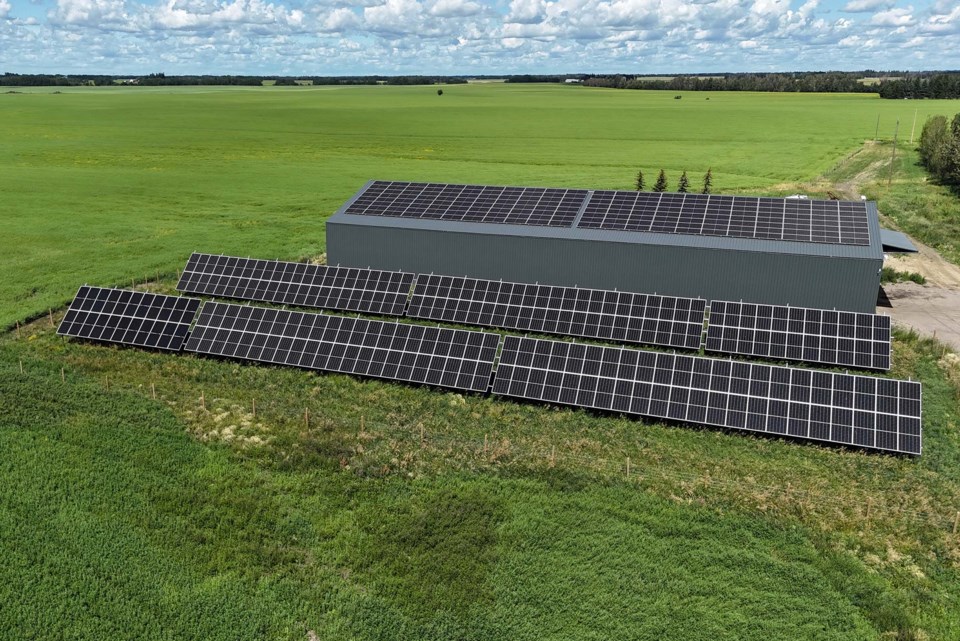How Now Green Cow
How Now Green Cow is examining how farms and food are shaping and being shaped by the climate crisis. Got a food and climate question? Send it to [email protected] so it can be addressed in a future story.
Conor Speers doesn’t just harvest grain on his farm near Namao. He also harvests the sun.
Speers covered a shop and about a half-acre of land on his farm with about 135 kW of solar panels in around 2023 — enough to power his home and farm. The solar power system cost him about $600,000, about half of which was covered by a federal grant. The system has eliminated his farm’s carbon footprint for electricity and should pay for itself in energy savings in about eight years.
“It’s a good economic decision,” he said of his investment, and (once he adds battery backup) will protect his operations against blackouts.
“I think energy is going to be more scarce in the future, and it’s very comforting producing your own power.”
Solar farming
Solar power has been a popular investment on farms since at least 2016 as a way to offset high electricity prices, said Heather Mackenzie, executive director of the non-profit solar energy advocacy group Solar Alberta. Some farmers, especially food processors, use lots of power and save money by producing their own energy. Others see solar as a way to get use out of poor-quality land or enhance their independence. Still others see solar as a way to act on global heating, the effects of which they see firsthand in the form of droughts and extreme weather.
“They’re on the front lines of climate change,” she said.
Lamont-area grain and cattle farmer Kirk Harrold said he initially got into solar for environmental reasons. His first attempt was a passive solar heater made from black paint, fibreglass, and chicken wire in the 1980s — one that heated the air inside it to 50 C in February and added 10 degrees to his shop’s temperature. He added about 6 kW of solar to that shop in 2012 and built a ground-based 13 kW system in 2019. The two arrays cover about 28 per cent of his farm’s electricity use.
“It’s our way of making a contribution to a lower-carbon society,” he said.
Farmers can use solar to power lights, heaters, water pumps, grain dryers, and other equipment, said Clifton Lofthaug, owner of Great Canadian Solar (which installed Harrold’s system and others in and around Sturgeon County). With the federal government’s new Clean Technology Investment Tax Credit (which offers a 30 per cent tax rebate on solar investments), most on-farm solar systems pay for themselves in five to eight years. Sturgeon County and St. Albert residents can also finance solar systems over time through their taxes through the Clean Energy Improvement Program.
“(With) the five-to-eight year payback combined with low-interest loans, it’s really a ‘Why wouldn’t you do it?’ scenario,” Lofthaug said.
Before you build
Lofthaug said roof-based systems are the cheapest option for on-farm solar, as ground-mounts required piles, racks, and excavation. Ground-mounts are easier to access, though, and a good alternative if you don't have a lot of roof space.
Lofthaug said solar won’t completely eliminate your electricity bills, as you still have to pay for distribution and administrative fees unless you go completely off grid, which requires expensive backup generators or battery storage. Battery systems generally aren’t worth it unless you have something that must have backup power, such as a large freezer.
“Economically speaking, it’s better to remain on the grid,” he said.
The economics of solar really depend on the price of electricity, Harrold said. Most systems today pay for themselves after 10 or 12 years, which was a pretty good investment, given that they will last about 20.
Harrold said maintenance on his system has been minimal, with just one panel replaced since he installed it. He and Speers said they like to clean the snow off their ground-based panels, although Speers acknowledged that he didn’t have to do so. (A 2018 Northern Alberta Institute of Technology study found that built-up snow reduces a solar panel’s output by just three per cent.)
Lofthaug said anyone looking to get solar should get at least three quotes from reputable installers, as some charge 50 per cent more than the industry rate. Research thoroughly, and be especially cautious with offers from door-to-door salespersons.
Speers said any farmer who uses a lot of electricity should look into solar for their operations.
“It’s passive diversified income for the farm.”



